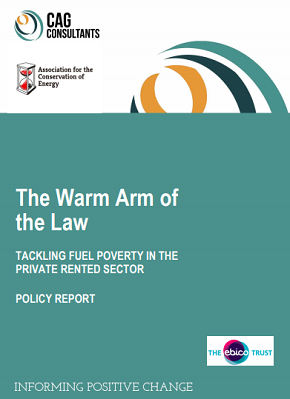The Warm Arm of the Law
In August 2018, the Association for the Conservation of Energy (ACE), working in partnership with CAG Consultants, published 'The Warm Arm of the Law'. This is an Ebico Trust-funded (through any profit made by the energy supplier Ebico) research project looking at the extent to which the Housing Health and Safety Rating System (HHSRS) and Minimum Energy Efficiency Standards (MEES) are being proactively implemented and enforced by local authorities across England and Wales.
The project was overseen by a steering group involving the Department for Business, Energy and Industrial Strategy, the Local Government Association, the Chartered Institute of Environmental Health, the Association of Local Authority Energy Officers and the Residential Landlords Association.
The private rented sector (PRS) has grown by over 40% in the last ten years and now comprises 20.5% of the housing market in England, compared to just 10% in 1999. Fuel poverty continues to be a major problem and is particularly acute in the PRS, with an estimated 21% of households thought to be in fuel poverty compared with other tenures, the PRS in England has the largest proportion of energy inefficient F and G rated properties.
As BRE have estimated the financial cost to the NHS from poor energy efficiency in the PRS, analyse the data generated by English Housing Survey surveyors for reporting to central government, and provide assistance to local authorities on better understanding their local position in terms of numbers and local distributions of private rented households and energy efficiency, they were invited to take part in the research (a lengthy stakeholder telephone interview took place in December 2017). The interview elicited views on how effective HHSRS/MEES are or could be in terms of raising the energy efficiency of privately rented properties.
The headline finding from the research is that local authorities are not doing enough to enforce minimum energy efficiency standards in the PRS. This is hardly surprising given the budget cuts, with local authorities reducing spend on enforcement activity by a fifth between 2009/10 and 2015/16.
Stakeholders reported mixed feelings about HHSRS, with some finding it useful for dealing particularly with cold hazards which may pose serious health concern and where there is no financial contribution limit, while others argued the guidance is ambiguous.
The introduction of simple minimum energy efficiency standards under MEES was felt by some to be a positive step, although some stakeholders felt it could only be effective if amended and additional resources made available for enforcement. Stakeholders also felt that there was a lack of clarity on how these two systems could work together.
The published 140-page report makes a number of recommendations including:
- National government needs to ensure that local government is adequately resourced to proactively implement both MEES and HHSRS and could offer guidance and advice on how these services can be implemented as cost effectively as possible.
- Local government needs to develop a joined-up approach to implementing HHSRS and MEES. National government could assist by issuing guidance and examples of how best to do this.
- Using HHSRS where an exemption has been lodged for MEES (e.g. in relation to the cost cap), and where a Category 1 Excess Cold hazard is anticipated to exist.
- Requiring EPC information to be collected as part of any selective and HMO licensing schemes in order to support the enforcement of HHSRS and MEES.
- Update the HHSRS Operating Guidance, particularly the health outcome statistics, definition of affordability and relationship between energy efficiency ratings and excess cold hazards.
BRE’s work in this area is referenced on a number of occasions, including:
- Research into the health costs of cold homes in the private rented sector (pages 6 & 15).
- The Excess Cold Calculator (XCC) – 'it was suggested that local government should have open access to BRE’s Excess Cold Calculator to enable them to successfully build a thorough evidence base for Tribunal appeals' (page 64), with the recommendation to 'provide open access to BRE’s Excess Cold Calculator to enable councils to build the evidence base to take to Tribunal appeals.' (page 87).
- Liverpool’s use of the HHCC – 'Another stakeholder noted that Liverpool City Council “secured £12m from landlords through being proactive and looking at housing in a zonal way'. The council were said to be proactive in improving properties before enforcement action was taken, and that they were able to secure buy in from statutory agencies through promoting the BRE’s Housing Health Cost calculator (which predicts avoidable costs to health sector from Category 1 and 2 hazards). (page 70 – not completely factually correct, but we’ll take it!)
This article was originally published here by BRE Buzz on 20 August 2018. It was written by Simon Guy.
--BRE Buzz
[edit] Find out more
[edit] Related articles on Designing Buildings Wiki
Featured articles and news
The UK's Modern Industrial Strategy: A 10 year plan
Previous consultation criticism, current key elements and general support with some persisting reservations.
Building Safety Regulator reforms
New roles, new staff and a new fast track service pave the way for a single construction regulator.
Architectural Technologist CPDs and Communications
CIAT CPD… and how you can do it!
Cooling centres and cool spaces
Managing extreme heat in cities by directing the public to places for heat stress relief and water sources.
Winter gardens: A brief history and warm variations
Extending the season with glass in different forms and terms.
Restoring Great Yarmouth's Winter Gardens
Transforming one of the least sustainable constructions imaginable.
Construction Skills Mission Board launch sector drive
Newly formed government and industry collaboration set strategy for recruiting an additional 100,000 construction workers a year.
New Architects Code comes into effect in September 2025
ARB Architects Code of Conduct and Practice available with ongoing consultation regarding guidance.
Welsh Skills Body (Medr) launches ambitious plan
The new skills body brings together funding and regulation of tertiary education and research for the devolved nation.
Paul Gandy FCIOB announced as next CIOB President
Former Tilbury Douglas CEO takes helm.
UK Infrastructure: A 10 Year Strategy. In brief with reactions
With the National Infrastructure and Service Transformation Authority (NISTA).
Ebenezer Howard: inventor of the garden city. Book review.
The Grenfell Tower fire, eight years on
A time to pause and reflect as Dubai tower block fire reported just before anniversary.
Airtightness Topic Guide BSRIA TG 27/2025
Explaining the basics of airtightness, what it is, why it's important, when it's required and how it's carried out.
Construction contract awards hit lowest point of 2025
Plummeting for second consecutive month, intensifying concerns for housing and infrastructure goals.
Understanding Mental Health in the Built Environment 2025
Examining the state of mental health in construction, shedding light on levels of stress, anxiety and depression.
























